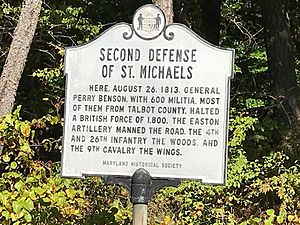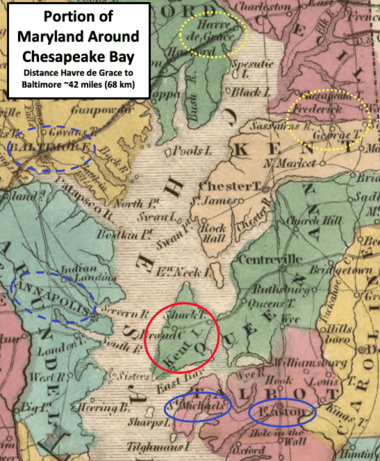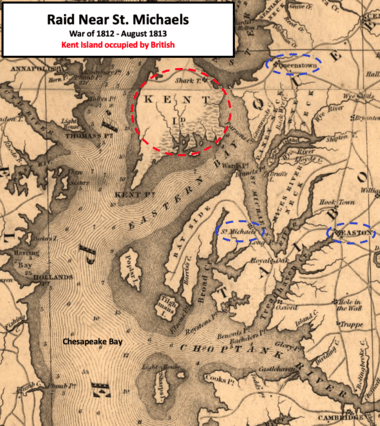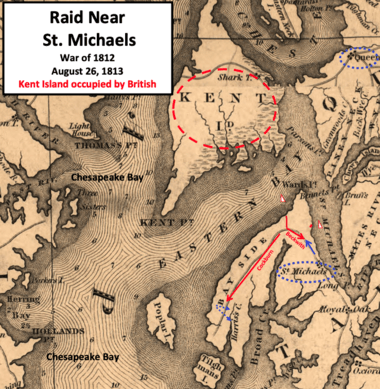Second Battle of St. Michaels facts for kids
Quick facts for kids Second Battle of St. Michaels |
|||||||
|---|---|---|---|---|---|---|---|
| Part of the War of 1812 | |||||||
 |
|||||||
|
|||||||
| Belligerents | |||||||
| Commanders and leaders | |||||||
| George Cockburn Thomas Sydney Beckwith |
Perry Benson | ||||||
| Units involved | |||||||
| Royal Navy * 1st Bn Royal Marines * 2nd Bn Royal Marines British Army * 102nd Regiment of Foot |
12th Maryland Brigade * 4th Maryland Regiment * 26th Maryland Regiment * 9th Cavalry District |
||||||
| Strength | |||||||
| Land: 2,100 |
Land: 500 | ||||||
| Casualties and losses | |||||||
| unknown | 14 captured | ||||||
The Second Battle of St. Michaels was an attack by British soldiers during the War of 1812. It happened on August 26, 1813, on Maryland's Eastern Shore. The fighting took place between Tilghman Island and the town of St. Michaels, Maryland. Local citizen soldiers, called militia, defended their homes against the British.
Communities on Maryland's Eastern Shore were important because they were close to the Chesapeake Bay. This bay was a main shipping route to big American cities like Baltimore and Washington, D.C.. St. Michaels was a target for the British because it was known for shipbuilding. Just two weeks before this battle, on August 10, the town was successfully defended by local militia in the Battle of St. Michaels.
On August 26, 1813, a large British force landed at Auld's Point early in the morning. They marched to the main road and then split into two groups. A smaller group of 300 soldiers went towards Tilghman Island. They burned two merchant ships and captured a few militiamen. Most of the militia escaped. The larger British group, about 1,800 soldiers, moved towards St. Michaels. They met Maryland militia, who were much smaller in number. After a short fight with artillery and muskets, the British surprisingly left.
Contents
Why the Battle Happened
The United States declared war on the United Kingdom of Great Britain and Ireland in June 1812. Not everyone in the U.S. agreed with this decision. The Federalist Party, made of bankers and businessmen, were against the war. But the Democratic-Republican Party, who had more members, believed the war was needed.
After the U.S. declared war, the British government blocked American ports. This meant ships could not easily enter or leave. In 1813, the British made this blockade stronger. They sent ships to close ports like New York and others further south, including those on the Chesapeake Bay. In February 1813, British ships, led by Rear Admiral George Cockburn, took control of Hampton Roads. This stopped all ship traffic in and out of the Chesapeake Bay. Major ports like Norfolk and Port of Baltimore were closed.
Starting in the spring of 1813, Admiral Cockburn began attacking towns along the Chesapeake Bay. These attacks involved destroying or taking property, including crops and farm animals. On May 3, Cockburn burned most of Havre de Grace, Maryland. More Maryland towns, Georgetown and Fredericktown, were burned on May 6. Cockburn said he would leave towns alone if they had no guns or militia.
Who Fought in the Battle
British Forces
Vice Admiral John Borlase Warren was the main commander for the British in North America. Admiral Cockburn reported to him. Cockburn led the August 26 attack near St. Michaels. He had eight ships and two battalions of Royal Marines. He also had the 102nd Regiment of Foot, which was an army regiment. About 2,100 British soldiers came ashore in 60 small boats called barges. Cockburn led 300 Royal Marines himself. Colonel Thomas Sydney Beckwith led a larger group of 1,800 men.
American Forces
Talbot County, where St. Michaels is located, was mainly defended by state militia in 1813. Maryland's militia was made up of different groups. Brigadier General Perry Benson, who had fought in the American Revolutionary War, commanded the 12th Maryland Brigade. This group included militia from Talbot, Caroline, and Dorchester counties.
General Benson's force at the battle had about 500 men. These included the 4th and 26th Maryland infantry regiments. They also had several cavalry companies from the 9th Cavalry District. The 4th Maryland Regiment had an artillery company and was mostly from Easton. The 26th Maryland Regiment had companies from the St. Michaels area. The 9th Cavalry District included companies from Easton, St. Michaels, and Trappe.
Before the Battle
In early August 1813, the British captured Kent Island in Maryland. This island is north of St. Michaels and across the bay from Annapolis, the state capital. The British landed about 3,000 men on the island. Most people living there had already left, so there was no fighting. Kent Island had food and fresh water. It became a base for British attacks on Maryland's Eastern Shore, Annapolis, Baltimore, and Washington.
During this time, British ships were in Eastern Bay, between Kent Island and St. Michaels. This worried people in nearby towns like Queenstown, St. Michaels, and Easton. St. Michaels was a target because of its shipbuilding. It had already been attacked on August 10. That day, local militia stopped the British from destroying the town. St. Michaels is on the St. Michaels River, which is a water route near Kent Island. This route could be used to get close to Easton. Easton had the Eastern Shore's only armory, a bank, and many goods the British could take.
British Return to Talbot County
Many of the Talbot County militia went home after the British attack on St. Michaels on August 10. But the August 13 attack on Queenstown, and rumors of a larger British fleet, put the county on alert again. Militia members were called back to prepare for a British invasion.
General Benson waited near St. Michaels with 500 to 600 militiamen. At 3:00 AM on August 26, the British sent 60 barges of troops to Auld's Point (also called Wade's Point) at Bayside. The HMS Conflict stayed nearby in the bay. At the same time, the HMS Highflyer and three smaller ships moved towards the St. Michaels River. Eleven more barges landed northwest of St. Michaels. The British told locals that more troops would land soon. They said property would be safe if people stayed in their houses.
Around dawn, Benson's lookouts saw the British near Auld's Point, about 6 miles (10 km) from St. Michaels. Rear Admiral Cockburn landed about 2,100 men with artillery. Cockburn planned to attack a militia camp he thought was between St. Michaels and Tilghman Island. He marched his men about 2 miles (3 km) to the main road. There, they split into two groups. Cockburn took 300 Royal Marines southwest towards Tilghman Island. Colonel Thomas Sydney Beckwith led the second group of about 1,800 men southeast towards St. Michaels.
The Battle Begins
Cockburn's Group
Cockburn did not find the militia camp because it did not exist. A small group of militia, led by Captain John Caulk, was patrolling the Bayside and Tilghman's Island area. When Caulk's men found their way to other militia forces blocked by Cockburn, they scattered. Most of them escaped by crossing Harris Creek. Those who were captured were taken from their homes. Two small ships were burned, and a lot of plunder (stolen goods) was taken.
Beckwith's Group
Beckwith marched his men along the Tilghman Island–St. Michaels road towards St. Michaels. He stopped where Porter Creek and Broad Creek are close to each other. He was about 2 miles (3 km) from St. Michaels, near Benson's militia. Benson's men were hidden in a wooded area. This made it hard for the British to know how many militia there were. Benson had three artillery guns in the middle of his line. Infantry and cavalry surrounded the guns.
The two sides eventually exchanged fire. But what the U.S. National Park Service calls "the largest Eastern Shore battle" of the War of 1812 lasted only a few artillery shots and musket volleys. The British "mysteriously withdrew," and no one knows for sure why they left.
After the Battle
The British left with their prisoners and stolen goods. Both forces were back on their ships by 5:00 PM. The British ships on the St. Michaels River and the barges at Hamilton's Point did not fight. The only known casualties were 14 militiamen captured by Cockburn. These prisoners were released the next day. On August 30, the British fleet was seen sailing south down the bay. So, most of the militia were sent home.
The British decided that attacking Annapolis and Baltimore would be a bad idea. These American cities had received many more soldiers. The British also wanted to leave the area before hurricane season started. By September, Cockburn had left for Bermuda. A small group of ships was left at the Virginia Capes to continue the blockade.
Almost exactly one year after the Second Battle of St. Michaels, the British burned the United States Capitol and the President's Mansion (White House) in Washington, DC. While Easton and Annapolis were not attacked during the war, Baltimore fought off the British in September 1814 during the Battle of Baltimore.
Today (2021), the Maryland Historical Trust has a historic marker near where Benson placed his militia. Not much else remains from the battle. Most discussions about the War of 1812 near St. Michaels focus on the artillery fight on August 10. The St. Michaels Museum at St. Mary's Square is a small museum near where Benson and his infantry waited during the August 10 battle. The Chesapeake Bay Maritime Museum is a larger exhibition hall. It is located on the north side of the St. Michaels harbor at Navy Point.
Images for kids






